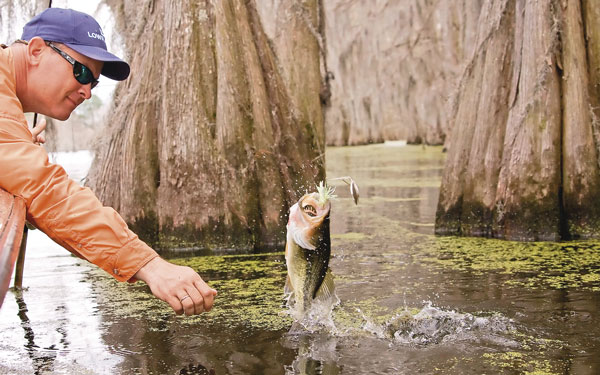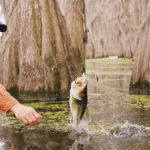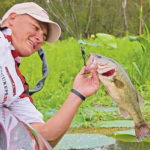
These bass-fishing techniques sound loony, but they produce plenty bites.
The orange-bladed spinnerbait that March Take Home Angler Matthew Hymel threw at Lake Cataouatche so threw me for a loop that I began to wonder if those gaudy blades were just the tips of the proverbial iceberg.
Those orange blades flat out worked. If something that off the wall works, there’s got to be other wacky stuff that bass anglers across Louisiana do to catch bass when nothing else seems to be delivering the goods.
I wasn’t sure if I would find extreme stuff like bass anglers purposefully fishing crappie jigs in a spawning bed, drilling holes to let all the rattles out of a lipless crankbait, or maybe even throwing that old pink crankbait that everybody jokes about.
I thought I would probably find more subtle stuff like fishing a lipless crankbait with one big rattle in it rather than 15 tiny ones. Or maybe it might even be that some angler targets a piece of cover or structure that nobody else even thinks about fishing.
Whatever tricks there may be out there that would allow me to catch bass while all the other boats around me could only wonder what was my secret, I just had to know what they were.
Five anglers from across the state willingly told me what they do differently to catch bass. Some of their ideas were eye-popping; some were of the why-didn’t-I-think-of-that variety. And these are only five ways of doing things just a little bit differently.
Imagine how many more secrets are being so closely held out there on the water that we may never know what they are. I’ll tell you what: I can’t wait to try out these five tips, and if I see somebody around me catching bass while I can’t, you can bet I’m going to politely sidle up beside them to see if they want to go on the record.
Cliff Crochet
This Bassmaster Elite Series pro from Pierre Part has received a crash course in doing something different since he first started fishing at such a high level of competition. And while he would love to provide some off-the-wall professional secret about some kind of strange bait that he throws, the truth is that he throws the same basic baits that you and I throw. Only, he throws them in a different place.
“The first thing I do in a crowd is look for the heaviest cover I can find,” Crochet began. “Thick, hard and heavy — like Cataouatche for example. There’s grass everywhere out there during the summer, and boats are all over the grass. Well, some of that grass is intimidating because it’s so thick. That’s exactly the kind of grass you should want to fish.”
Crochet theorized that all the noise from boats fishing the easy-to-fish outside edges of the grass mats pushes bass back into the thickest mats where people just don’t go. Not only are these kinds of places hard to get to, but they’re hard to fish and hard to drag fish out of as well. But if that’s where the bass feel most protected, that’s where you can bet Crochet is going to be.
“Sometimes it’s just running my trolling motor on high and cleaning it out two or three times to finally get somewhere,” Crochet added. “Sometimes it takes running my motor hot where the alarm is going off.
“Whatever it takes is whatever it takes. I don’t worry about making noise going in, but I do let it chill a while before I start fishing once I get back in there.”
The first baits Crochet reaches for when he first fishes such thick, inaccessible mats of grass are those he called “stupid baits.” Not that a Horny Toad or Ribbit are stupid baits, but they are baits that a stupid bass that hasn’t seen too many lures will attack with reckless abandon.
“And when you get back in a thick place, you’d be surprised at all the little subtle things you’ll find like a hole in the grass or lilies mixed in,” Crochet said. “Subtle changes in thick grass mats that intimidate other anglers are just the ticket if you’re looking to do something different than everybody else.”
Dennis Tietje
You’re not going to get Roanoke-based Bassmaster Elite Series pro Dennis Tietje to ever admit to having impulsively whipped out his credit card during the middle of the night to purchase the Flying Lure that he saw on television, but you just might wonder how many of them he has hiding in his tackle closet when you hear about his off-the-wall trick.
Tietje may not fish his secret stash of Flying Lures, but he does rig a NetBait 9-inch Super T-Mac straight-tail worm so that it does a little backing up of its own. He backs that thing up by inserting a Lunker City Herb Reed Insert Weight into the tail of the T-Mac.
“Rig it like you would a regular Texas-rigged worm, but don’t add a weight onto your line,” Tietje explained. “Then take an insert weight and stick it into the tail, but don’t stick it straight in from the back, or it will throw out when you cast. Stick it in the tail, but insert it from front to back so it will stay in.”
Postspawn is prime time for fishing a tail-weighted straight tail worm because bass during this period are notorious for running intruders out of a bed without ever biting. They’ll charge a lure but stay behind it the whole time. When Tietje drops his rod tip, his tail-weighted worm swims right back in the fish’s face.
“He can’t help but eat it when
it does that,” Tietje added. “He’s either got to eat it or get out of
its way.
“And this worm is just as effective in deep water as it is shallow. I really like throwing it around the corners of a deep bed of hydrilla, but it will also work on bare points and in brushpiles.”
Kenny Covington
He’s not a Bassmaster Elite Series pro angler, but the locals around West Monroe hate to see Kenny Covington’s name on the list of regional tournament entrants just as well. His consistency in catching bass and his ability to read water match up with any angler in the state.
Covington revealed that one of the secrets to his success is that he does something he calls power fishing finesse baits. When he broke that down for me, all it really meant was that he fishes small baits with regular casting tackle.
“My big — or should say little — three are a Norman Tiny N crankbait, which they also call a crappie crankbait, a Strike King Bitsy Bug and a 1/8-ounce Stanley spinnerbait,” Covington said. “With those three baits, I can catch fish anywhere, but they really shine in river systems and lakes where a 13-pound five-fish limit would be considered a good bag.”
While it’s not much of a revelation that a bass angler fishes a small bait, Covington says it is a little different that he fishes these small offerings with casting rods and reels with line up to 20-pound-test. He believes these finesse baits work just as well on 15-pound-test P-Line as they do on 8-pound-test line.
“And those small baits catch some big bass, too,” Covington said. “I can’t tell you how many big bass pots I’ve won on that Bitsy Bug.
“And I doctor the Tiny N up by adding a No. 6 treble hook to the belly and a No. 4 on the back. It doesn’t take away any action, but it helps hold those bigger bass better.”
Although Covington says he can take these three tiny baits to any water and catch fish, he feels most at home with them when that water has boat docks that get pounded by big jigs, worms and spinnerbaits all day long. He can come behind other anglers and skip these small baits around those same docks and catch bass those before him left behind.
Homer Humphreys
This veteran of the professional bass wars from Minden has been fishing long enough to know exactly what he’s going to do when he’s fishing in a crowd. In fact, he just recently used his off-the-wall technique to finish 26th in the Bassmaster Central Open on Lewisville Lake in Texas.
“We had a window of an hour and a half to catch fish on a jerkbait in the coves, and that was it,” Humphreys said. “After that, you might catch one more the rest of the day, and you might not.
“Lewisville is a small lake, and every cove and creek had four to eight boats coming through at any one time all day long. Not only was the fishing pressure rough, but we were dealing with front after front coming through.”
In these kinds of conditions, Humphreys relied on his bread-and-butter technique, Carolina-rigging.
That may not sound very exciting, but what Humphreys was fishing on the business end of his Carolina rig should make you sit up and take notice.
“I found the mouth of a cove that was maybe 30 feet wide,” Humphreys recalled. “I could tell on my Humminbird Side Imaging, one side of this little mouth had a swag in it like a slough. I started fishing a 6-inch lizard on my Carolina rig, but I only got a couple pecks. That’s when I switched to a 5-inch solid black lizard.”
Humphreys learned about the magic of a 5-inch black lizard from “Old Man Sistrunk” down at Toledo Bend. All he ever seemed to throw was a black Mister Twister lizard, and he told Humphreys one day that all he ever saw around the lake were black lizards.
“You look in 100 people’s boxes, and you won’t find one solid black lizard,” Humphreys insisted. “You’ll find black/blue and black/red flake, but you won’t find solid black. It’s such a natural-looking color, and it’s something that the fish just don’t see. I use the 5-inch size not because it’s an inch shorter, but because it’s shorter and presents a smaller overall profile.”
Chris Burnham
This Lake D’Arbonne resident makes the popular Mr. Hooty spinnerbaits, but his oddball tip doesn’t have anything to do with blades. His rule of thumb the last five to 10 years has been to go the opposite direction of everybody that’s downsizes their lures and fishes them slowly during high-pressure conditions.
“When everybody said to go small and fish slow, I go the other way and go big and fish slow,” Burnham said. “And just by going big, I’m doing something different than everybody else out on the lake. When everybody’s grabbing a shaky head or a Bitsy Bug, I reach for a 7-inch Zoom Super Magnum Fluke.”
Although the bigger Fluke is only 2 inches longer than a regular Super Fluke, Burnham says this version is a giant hunk of plastic that’s almost the same girth of a Coke can. He hated to expose his secret, but Burnham knows he can’t keep his hat on it forever.
“I can take that Magnum Fluke and go to the same areas where everybody else is throwing a shaky head and throw that big nasty sucker in there and work it like a Senko,” Burnham said. “During the summer, I twitch it near the surface, but during the spring, I let it fall to the bottom, and then I lift my rod tip up 90 degrees toward the sky.”
Burnham continues to lift and drop his big Fluke all the way back to his boat. He related the action as to what your daddy taught you to do when you first learned how to fish a plastic worm. And although a twitching retrieve may work better during the summer, Burnham fishes it more like a dead stick during the spring.
“It’s been my No. 1 bait the last year or so,” Burnham said. “I fish it all year long, and I’ve caught more fish on it than any other bait I threw within the last year.
“I must have gone through $100 a month in those things for the last 12 months.”
Burnham says the key to getting the best action out of the big Fluke is to rig it on an extra-wide-gap heavy wire hook tied to 25-pound-test fluorocarbon line and with a really stiff rod.
“And you’ve got to plow them when they eat it,” Burnham said. “It’s a hunk of plastic, and you just won’t be able to set the hook with a light wire hook.
“I’ve tried it on braid, but the 25-pound fluorocarbon sinks just right for this bait.”
You may never have had to watch these five anglers stroking bass after bass while you poked around trying to figure out what to do, but you can bet these tips were what they were using if you have.
If you don’t think they’re telling the truth, put their out-of-the-ordinary techniques to use the next time you go fishing. Just make sure you’re ready for everybody around you to ask what you’re doing different.




